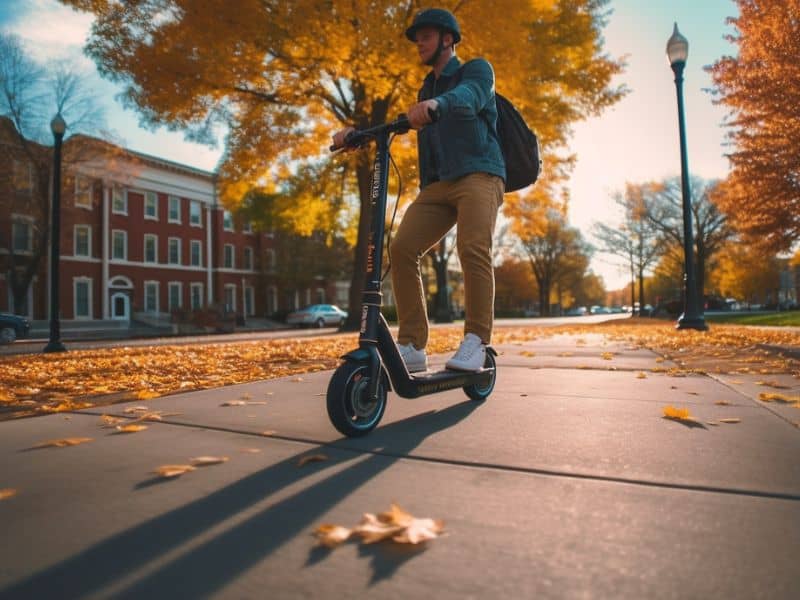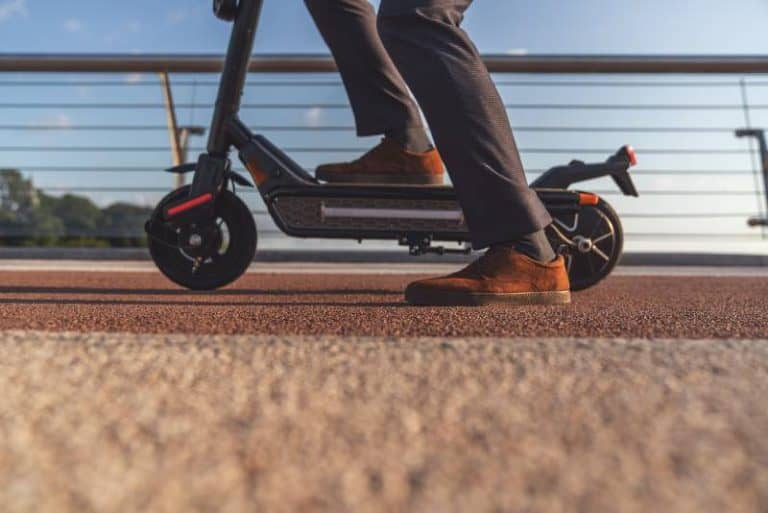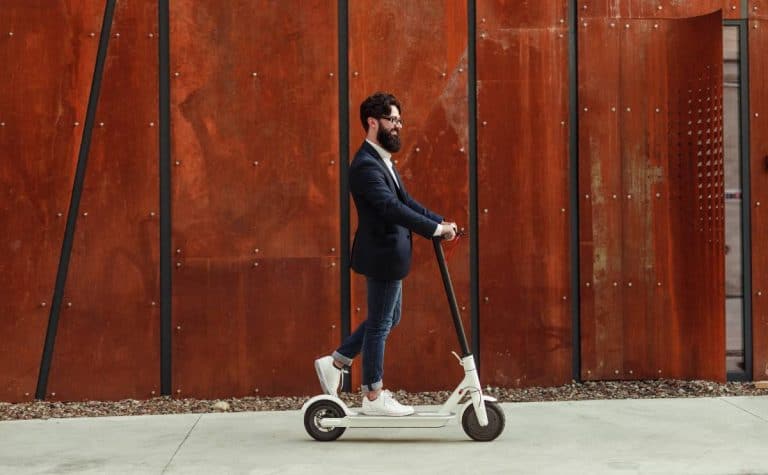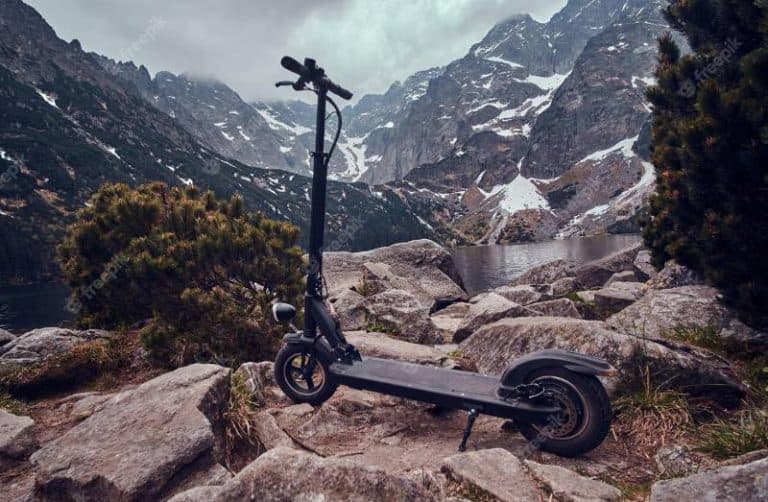Riding to Class: The Surge of Electric Scooters in Colleges
As college campuses embrace high-tech transportation solutions, the use of electric scooters is becoming increasingly popular. From relieving parking headaches for students to providing an environmentally friendly option for those going from one destination to another, electric scooters have become a great way to quickly and conveniently get around campus grounds. But as these vehicles take center stage on college campuses across the country, it’s important for universities and institutions to understand both their pros and cons in order to be prepared when implementing these innovative technologies. In this post, we’ll discuss why universities are choosing the best electric scooter programs and what potential issues could arise with different types of implementation plans.
Due to limited parking and a focus on sustainability, college, and university leaders have been promoting alternative transportation for students for many years. Electric scooters have recently become a popular mode of transport on campuses and in cities, but officials are approaching their use with caution due to safety concerns.
Key Takeaways
- Escooters have emerged as a valuable tool for promoting sustainable transportation. They help reduce carbon emissions, increase energy efficiency, decrease traffic congestion, and promote the use of renewable energy.
- Campuses are effectively adapting by developing comprehensive rules for e-scooter usage, designating parking zones, promoting safe riding habits, and partnering with e-scooter companies to control the number and use of these devices.
- The safety of e-scooter users is paramount. This involves the use of safety gear such as helmets, elbow and knee pads, wrist guards, and reflective clothing.
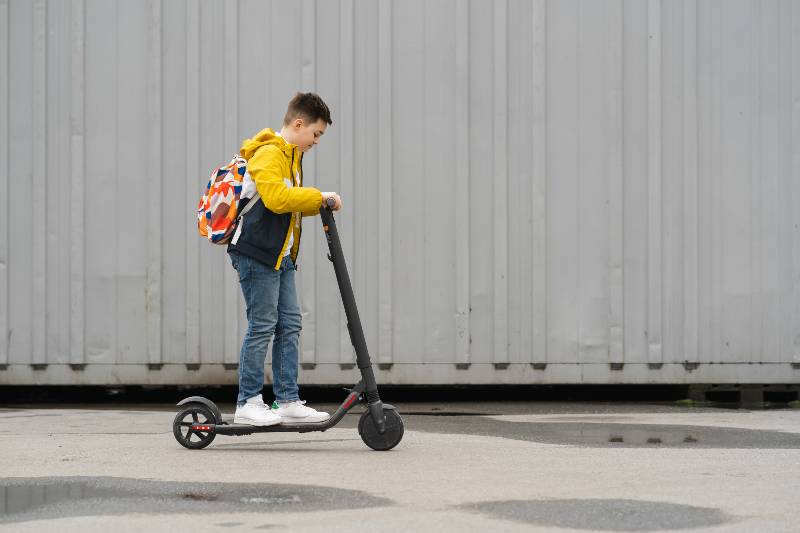
The Rising Popularity of Electric Scooters
The rising popularity of electric scooters (e-scooters) can be attributed to a multitude of factors. It’s a trend that’s becoming particularly noticeable in urban areas and on university campuses. Here are some of the main reasons for this increasing adoption:
- Environmental Sustainability: E-scooters are powered by electricity, making them a much cleaner alternative to traditional gas-powered vehicles. They produce zero direct emissions, helping to reduce the overall carbon footprint.
- Cost-Efficiency: E-scooters have low operating costs. They require less energy to run and their maintenance cost is significantly lower than that of traditional vehicles.
- Convenience: E-scooters are compact and lightweight, which makes them extremely convenient for short-distance travel, particularly in congested urban areas where parking is limited and traffic is heavy.
- Technological Advancements: Technological advancements have made e-scooters safer and more efficient than ever before. Features like GPS tracking, ride-sharing applications, and improved battery life have all contributed to their increasing popularity.
- Health and Safety Measures: Amid the COVID-19 pandemic, e-scooters emerged as a safer mode of transportation, offering an option that allowed for social distancing and reduced the need to touch public surfaces.
When it comes to benefits for students and faculty, there are several advantages:
- Easy Campus Navigation: University campuses can be vast, and getting from one end to another can be time-consuming. E-scooters provide a quick and easy solution for moving around campus.
- Reduced Transportation Costs: Students and faculty members can significantly cut down on their transportation costs by using e-scooters for daily commuting.
- Flexibility: E-scooters offer flexibility in terms of when and where to travel, unlike public transportation which operates on fixed schedules and routes.
- Promotes Physical Activity: While they’re not as strenuous as biking, riding an e-scooter still requires a certain level of physical activity, which can contribute to overall health and fitness.
- Space Efficiency: With limited parking spaces on many campuses, e-scooters can be a great solution as they require much less space than cars.
- Community Building: Many universities have started to introduce e-scooter sharing programs, which not only promote sustainability but also foster a sense of community among students and staff.
As with any mode of transportation, safety is a concern with e-scooters, so it’s important for riders to use them responsibly. This includes wearing a helmet, following traffic rules, and being aware of pedestrians and other vehicles.
The Role of Electric Scooters in Sustainable Transportation
Electric scooters (e-scooters) play a significant role in sustainable transportation. As our society becomes increasingly aware of the need for environmental conservation, e-scooters are seen as a viable solution due to their numerous environmental benefits and potential to reduce carbon footprints.
- Reduced Carbon Emissions: The most significant environmental benefit of e-scooters is their ability to reduce greenhouse gas emissions. Traditional gasoline-powered vehicles are significant contributors to air pollution and global warming. E-scooters, on the other hand, are powered by electricity, which results in zero tailpipe emissions. While the process of generating electricity may produce some emissions, it is still significantly less than those produced by gasoline vehicles, particularly if the electricity comes from renewable sources.
- Energy Efficiency: E-scooters are more energy-efficient compared to cars and even public transportation. They require less energy to operate, which leads to fewer emissions per mile.
- Reduced Traffic Congestion: E-scooters can help reduce the number of cars on the road, leading to less traffic congestion. This not only reduces the amount of time people spend commuting but also cuts down on the emissions caused by idling cars.
- Reduced Noise Pollution: E-scooters produce significantly less noise than traditional vehicles. This reduction in noise pollution can contribute to a more pleasant urban environment and improve the quality of life in densely populated areas.
- Promotion of Renewable Energy: The rise in popularity of e-scooters is encouraging the development and use of renewable energy sources. Many e-scooter companies are investing in charging stations powered by solar energy, further reducing their environmental impact.
- Reduced Land Use for Parking: Compared to cars, e-scooters require less space for parking, which can lead to a reduction in the size of parking lots. This, in turn, can create more room for green spaces in urban areas, promoting better air quality and providing habitats for wildlife.
Using e-scooters for urban transportation can greatly decrease carbon footprint and promote sustainable living. As e-scooter technology improves, it will likely become even more important in sustainable transportation.
Choosing the Right Electric Scooter for Campus Life
Purchasing an electric scooter is a significant investment, and there are a few key considerations to keep in mind when buying college electric scooters:
- Range: One of the most important factors to consider is the scooter’s range, or how far it can travel on a single charge. Make sure it’s sufficient for your daily commute or typical usage.
- Weight Capacity: Check the weight limit of the scooter to ensure it can comfortably and safely carry you.
- Speed: While all e-scooters are designed to be safe, some have higher top speeds than others. If speed is a priority for you, check the maximum speed before purchasing.
- Weight of the Scooter: If you’ll need to carry your scooter frequently (up stairs, for example), consider its weight. Lighter models will be easier to transport.
- Safety Features: Look for scooters that have robust safety features, such as efficient brakes, reliable tires, and good lighting for night use.
- Price: As with any purchase, price is a consideration. More expensive models may have more features or better performance, but there are also many affordable options that could meet your needs.
- Durability and Maintenance: Check the build quality of the scooter and the reputation of the manufacturer. Some models may also require more maintenance than others.
- Warranty: A warranty can provide peace of mind in case anything goes wrong with the scooter.
Now, let’s look at the best electric scooters for college campuses:
- GoTrax GXL V2 ($349): This is a great budget-friendly option that doesn’t skimp on features. It has a range of 12 miles, a top speed of 15.5 mph, and it’s lightweight and portable.
- Turboant M10 ($359.98): This scooter is an Editor’s Pick for good reason. It offers a solid range of 16 miles, a top speed of 19.9 mph, and can support up to 220 lbs. It’s also foldable for easy transport and storage.
- Turboant X7 Pro ($399.98): The X7 Pro boasts a long maximum range of 30 miles and a top speed of 20 mph. Its battery is detachable, allowing you to charge it separately from the scooter.
- GoTrax G4 ($549): While it’s the most expensive option on this list, the G4 offers a number of premium features. It has a range of 25 miles, a top speed of 20 mph, and includes features like an LED display, cruise control, and a lock mechanism.
It is important to keep in mind that the ideal e-scooter for you will vary based on your personal requirements and situation. Take into account factors such as your intended usage, the locations where you will be utilizing it, and which features hold the most significance for you.
The Impact of E-Scooters on Campus Infrastructure and Policy
The influx of e-scooters on campuses has prompted several changes in infrastructure and policy. Campuses are adapting by implementing a variety of measures to manage the use of these devices and ensure safety and convenience for all.
Many universities are developing policies that outline where e-scooters can be ridden and parked. They are designating specific areas for parking to prevent scooters from blocking sidewalks, doorways, and handicap-accessible areas. Some campuses are also creating dedicated lanes for e-scooters and other personal transport devices to separate them from pedestrian traffic and reduce the risk of accidents.
In terms of infrastructure, some campuses are investing in the installation of charging stations for e-scooters, often in collaboration with e-scooter companies. These stations serve not only as a convenience for riders but also as a way to encourage the use of e-scooters as a sustainable transportation option.
Moreover, in an effort to control the number of e-scooters on campus, several universities have entered into agreements with specific e-scooter companies. These partnerships allow universities to limit the number of scooters on campus, regulate their use, and often include provisions for companies to contribute to the maintenance of campus infrastructure.
Education and enforcement are also key aspects of campus policy adaptations. Universities are running campaigns to educate students and faculty about the rules and etiquette of e-scooter use. Some have introduced penalties for misuse, like improper parking or reckless riding.
In essence, the introduction of e-scooters is reshaping campus transportation policies and infrastructure. The goal is to integrate these devices in a way that supports sustainable transportation, enhances mobility, and maintains safety and accessibility for all campus community members.
E-scooters have become a common sight on many college campuses, and with their increased presence, universities have had to establish policies and regulations to maintain safety and order. Here are a few examples of how different colleges are handling e-scooter policies:
- University of California, Los Angeles (UCLA): UCLA has established a comprehensive set of rules for e-scooters. They include speed limits, restrictions on where scooters can be ridden, and designated parking areas. The university also partnered with a scooter company to introduce a geofencing system that automatically slows scooters when they enter pedestrian-heavy areas.
- Ohio State University: Ohio State University has worked with the city of Columbus and scooter companies to develop policies for e-scooter use. These include speed limits, rules about yielding to pedestrians, and prohibitions on riding on certain paths and inside buildings.
- University of Texas, Austin: UT Austin has designated parking areas for scooters and has established fines for improper parking. They’ve also launched an educational campaign to encourage safe riding habits, like wearing a helmet and following traffic laws.
- Purdue University: Purdue University has banned e-scooters from campus sidewalks, instead requiring that they be ridden on bike lanes or streets. They’ve also partnered with scooter companies to cap the number of scooters on campus and ensure that they are parked correctly.
- Stanford University: Stanford has implemented strict rules for e-scooters, including a ban on riding at night without lights, a prohibition on riding in certain areas, and the requirement of helmets for all riders. The university also provides free helmets for students and staff.
- San Diego State University: Non-motorized bicycles, scooters, and skateboards are permitted on curbed roadways of campus, and on the designated bike path on Aztec Walk and Campanile Mall. All riders are required to follow SDSU regulations and park all bikes at a bike rack, cage or designated corral area.
While these are specific examples, they demonstrate the types of rules that are common across many universities: speed limits, designated parking areas, restrictions on where scooters can be ridden, and safety requirements like wearing helmets. It’s important for students and staff to familiarize themselves with their university’s specific rules for e-scooter use to ensure they are riding safely and responsibly.
Safety Considerations for Electric Scooters
Safety is an essential aspect of using electric scooters, and riders should be aware of the potential risks associated with their use. To ensure a safe experience, riders must prioritize the use of safety gear and adopt safe riding practices and habits.
Safety Gear:
The importance of safety gear cannot be overstated, as it significantly reduces the risk of injuries in the event of an accident.
- Helmet: Wearing a helmet is crucial, as it protects your head from severe injuries in case of a fall or collision. Choose a helmet that fits properly and meets safety standards.
- Elbow and Knee Pads: These pads can help protect against scrapes, cuts, and bruises in case of a fall.
- Wrist Guards: Wrist guards can provide support and prevent wrist injuries during a fall.
- Reflective Clothing and Lights: Wearing reflective clothing and attaching lights to your scooter can make you more visible to others, especially in low-light conditions or during nighttime rides.
Safe Riding Practices and Habits
- Follow Traffic Rules: Please make sure to follow all traffic regulations, including coming to a complete stop at traffic lights and stop signs, giving way to people walking, and utilizing designated lanes if they are accessible.
- Stay Alert: Pay attention to your surroundings, watch out for obstacles, and be prepared to react to changes in traffic conditions or the actions of other road users.
- Ride at a Safe Speed: Maintain a speed that allows you to react to unexpected situations and maintain control of your scooter.
- Keep Both Hands on the Handlebars: Ensure that you have full control over your scooter by keeping both hands on the handlebars at all times.
- Avoid Distractions: Refrain from using your phone or wearing headphones while riding to maintain full awareness of your surroundings.
- Use Hand Signals: Communicate your intentions to other road users by using hand signals when turning or stopping.
- Inspect Your Scooter: Regularly check your scooter for potential issues, such as tire pressure, battery charge, and brake functionality, to ensure it is in good working condition.
Electric scooters offer a convenient and eco-friendly mode of transportation for many city dwellers. However, safety is vital when operating these vehicles. By prioritizing safety gear like helmets and knee pads, and sticking to safe habits, like obeying traffic rules and avoiding distracted riding, riders can reduce the risk of accidents and injuries while enjoying the benefits of electric scooters.
For more information about the rise of sharing electric scooters and how they’re changing urban transportation, read on here.
Case Studies of Successful E-Scooter Implementation in Colleges
E-scooter programs have been successfully implemented in numerous colleges, contributing to more sustainable transportation options and improved campus mobility. Here are three case studies highlighting successful e-scooter implementations:
- University of California, Los Angeles (UCLA): UCLA has implemented an extensive e-scooter program, which includes partnerships with e-scooter companies like Bird and Lime. They have established clear rules for riders, such as speed limits and designated parking areas, ensuring that e-scooters do not obstruct sidewalks or other public spaces. Moreover, UCLA has implemented a geofencing system, which automatically reduces scooter speeds in high-traffic pedestrian areas. Their successful management of e-scooter usage has made it an attractive transportation option for students and staff, leading to a reduced carbon footprint and improved campus mobility.
- Arizona State University (ASU): ASU has also embraced e-scooters as a sustainable transportation option. They have designated parking zones for e-scooters and implemented strict penalties for improper parking, ensuring that the devices do not obstruct walkways or create hazards. ASU has partnered with e-scooter companies to ensure a controlled number of scooters on campus and to provide charging infrastructure. As a result, e-scooters have become a popular means of transportation for students, helping to reduce traffic congestion and support the university’s sustainability goals.
- Purdue University: Purdue University has successfully integrated e-scooters into its campus transportation system by setting strict rules and regulations. E-scooters are not allowed on sidewalks, and riders must use bike lanes or streets. Purdue has partnered with e-scooter companies to limit the number of devices on campus and ensure they are parked correctly. They have also provided clear guidelines for e-scooter usage, educating students and staff on safe riding practices. This well-managed e-scooter program has contributed to a more sustainable and efficient transportation system on campus.
These case studies illustrate the positive impact e-scooters can have on college campuses when they are properly managed and integrated into the transportation infrastructure. By establishing clear rules, partnering with e-scooter companies, and promoting safe riding habits, these universities have successfully adopted e-scooters as a sustainable and efficient transportation option.

Electric Scooters In College Campuses FAQs
What are the campus policies generally in place for electric scooters?
Many colleges enforce rules for e-scooter riders. These rules usually include following local traffic laws like stopping at stop signs and following speed limits. Riders are also required to wear helmets and not ride in pedestrian areas. Colleges work with e-scooter companies to control the number of scooters on campus and to make sure they are parked correctly.
What safety measures should I take when riding an electric scooter on campus?
To ride an electric scooter on campus safely, ensure that you wear a helmet and abide by all relevant traffic regulations. Watch out for pedestrians, bicyclists, vehicles, or obstacles that may pose a threat. Before taking a ride, familiarize yourself with the e-scooter company’s rules and regulations.
Are there any specific electric scooter models recommended for college students?
The choice of the optimal electric scooter for college students varies based on their requirements. Foldable models are most favorable for swift commutes, as they are easily portable. Students in need of more power and distance should prioritize electric scooters equipped with larger motors and batteries. Besides, factors like the scooter’s weight capacity and safety provisions should also be taken into account.
How are college campuses adapting their infrastructure to accommodate electric scooters?
To make it easier for electric scooter users on college campuses, infrastructure and services such as charging stations, bike lanes, and designated parking areas are being put in place. Universities have also partnered with e-scooter companies to manage the number of devices on campus, making transportation more efficient.
Can I ride an electric scooter if my college campus is hilly or uneven?
Yes, most modern electric scooters are designed to handle hilly terrain and uneven surfaces. There are models with advanced features such as hill climb assistance, front and rear suspension, anti-lock brakes, dual braking system, and wide tires that make riding on hilly areas more comfortable and safer. Thus, it is essential to consider these features before purchasing an e-scooter for college campuses.
Are electric scooters good for college students?
Yes, electric scooters are great for college students. Though you have to do your research so you can find the perfect electric scooter for your needs for you to have a smooth and comfortable ride.
Conclusion
As great for college students as they are an affordable, efficient, and eco-friendly way to get around campus. They can also be used for short trips to nearby places such as parks or coffee shops. Moreover, most e-scooter models come with features that help riders navigate hilly terrain and uneven surfaces safely. Therefore, electric sc electric scooters continue to become a popular transportation option for college campuses across the country, it is important for students, faculty, and staff members to recognize the advantages these devices bring along with the importance of following safety protocols. Together, we must equip ourselves with knowledge about appropriate usage regulations, e-scooter safety gear, and proper designations.
Let us use this opportunity to advocate for efficient and sustainable transit solutions that benefit everyone. By increasing access to efficient transportation, we can reduce our collective carbon footprint and help create a better future. So why wait? If you’re interested in taking action, sign up for our newsletter as together we will strive towards a more sustainable world through electric scooters.
